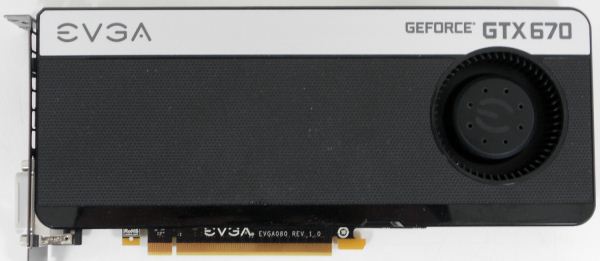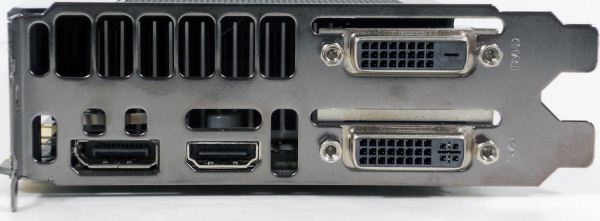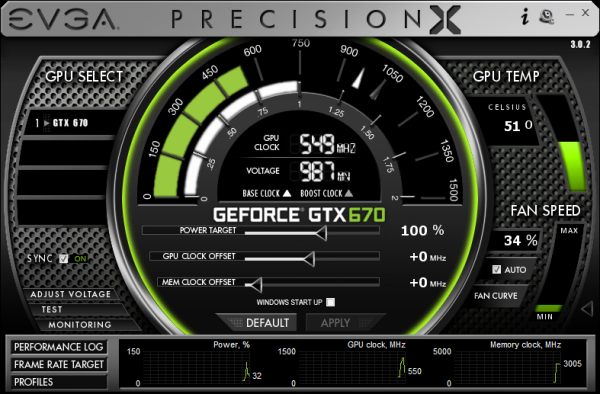NVIDIA GeForce GTX 670 Review Feat. EVGA: Bringing GK104 Down To $400
by Ryan Smith on May 10, 2012 9:00 AM ESTMeet The EVGA GeForce GTX 670 Superclocked
Our second card of the day is EVGA’s GeForce GTX 670 Superclocked, which in EVGA’s hierarchy is their first tier of factory overclocked cards. EVGA is binning GTX 670s and in turn promoting some of them to this tier, which means the GTX 670 Superclocked are equipped with generally better performing chips than the average reference card.
| GeForce GTX 670 Partner Card Specification Comparison | ||||
| EVGA GeForce GTX 670 Superclocked | GeForce GTX 670 (Ref) | |||
| CUDA Cores | 1344 | 1344 | ||
| Texture Units | 112 | 112 | ||
| ROPs | 32 | 32 | ||
| Base Clock | 967MHz | 915MHz | ||
| Boost Clock | 1046MHz | 980MHz | ||
| Memory Clock | 6210MHz | 6008MHz | ||
| Memory Bus Width | 256-bit | 256-bit | ||
| Frame Buffer | 2GB | 2GB | ||
| TDP | 170W | 170W | ||
| Manufacturing Process | TSMC 28nm | TSMC 28nm | ||
| Width | Double Slot | Double Slot | ||
| Length | 9.5" | 9.5" | ||
| Warranty | 3 Years | N/A | ||
| Price Point | $419 | $399 | ||
For the GTX 670 SC, EVGA has given both the core clock and memory clock a moderate boost. The core clock has been increased by 52MHz (6%) to 967MHz base and 66MHz (7%) boost to 1046MHz. Meanwhile the memory clock has been increased by 202MHz (3%) to 6210MHz.
Other than the clockspeed changes, the GTX 670 SC is an almost-reference card utilizing a reference PCB with a slightly modified cooler. EVGA is fabricating their own shroud, but they’ve copied NVIDIA’s reference shroud down to almost the last detail. The only functional difference is that the diameter of the fan intake is about 5mm less, otherwise the only difference is that EVGA has detailed it differently than NVIDIA and used some rounded corners in place of square corners.
The only other change you’ll notice is that EVGA is using their own high flow bracket in place of NVIDIA’s bracket. The high flow bracket cuts away as much metal as possible, maximizing the area of the vents. Though based on our power and temperature readings, this doesn’t seem to have notably impacted the GTX 670 SC.
While we’re on the matter of customized cards and factory overclocks, it’s worth reiterating NVIDIA’s position on factory overclocked cards. Reference and semi-custom cards (that is, cards using the reference PCB) must adhere to NVIDIA’s power target limits. For GTX 670 this is a 141W power target, with a maximum power target of 122% (170W). Fully custom cards with better power delivery circuitry can go higher, but not semi-custom cards. As a result the flexibility in building semi-custom cards comes down to binning. EVGA can bin better chips and use them in cards such as the Superclocked – such as our sample which can go 17 boost bins over the base clock versus 13 bins for our reference GTX 670 – but at the end of the day for stock performance they’re at the mercy of what can be accomplished within 141W/170W.
In any case, as the card is otherwise a reference GTX 670 EVGA is relying on the combination of their factory overclock, their toolset, and their strong reputation for support to carry the card. EVGA has priced the card at $419, $20 over the GTX 670 MSRP, in-line with other factory overclocked cards.
On the subject of pricing and warranties, since this is the first EVGA card we’ve reviewed since April 1st, this is a good time to go over the recent warranty changes EVGA has made.
Starting April 1st, EVGA has implemented what they’re calling their new Global Warranty Policy. Starting July 1st, 2011 (the policy is being backdated), all new EVGA cards ship with at least a 3 year warranty. And for the GTX 600 series specifically, so far EVGA has only offered models with a 3 year warranty in North America, which simplifies their product lineup.
To complement the 3 year warranty and replace the lack of longer term warranties, EVGA is now directly selling 2 and 7 year warranty extensions, for a total of 5 and 10 years respectively. So instead of buying a card with a 3 year warranty or a longer warranty, you’ll simply buy the 3 year card and then buy a warranty extension to go with it. However the extended warranty requires that the card be registered and the warranty purchased within 30 days.
The second change is that the base 3 year warranty no longer requires product registration. EVGA has other ways to entice buyers into registering, but they’ll now honor all applicable cards for 3 years regardless of the registration status. At the same time the base 3 year warranty is now a per-product warranty (e.g. a transferable warranty) rather than per-user warranty, so the base warranty will transfer to 2nd hand buyers. The extended warranties however will not.
The third change is how EVGA is actually going to handle the warranty process. First and foremost, EVGA is now allowing cards to be sent to the nearest EVGA RMA office rather than the office for the region the card was purchased from. For example a buyer moving from Europe to North America can send the card to EVGA’s North American offices rather than sending it overseas.
Finally, EVGA is now doing free cross shipping, alongside their existing Advanced RMA program. EVGA will now cross-ship replacement cards for free to buyers. The buyer meanwhile is responsible for paying to ship the faulty card back and putting up collateral on the new card until EVGA receives the old card.
There’s also one quick change to the step-up program that will impact some customers. With the move to purchasing extended warranties, the step-up program is only available to customers who either purchase an extended warranty or purchase an older generation card that comes with a lifetime warranty. Step-up is not available to cards with only the base 3 year warranty.
Moving on, along with EVGA’s new warranty EVGA is bundling the latest version of their GPU utilities, Precision X and OC Scanner X.
Precision X, as we touched upon quickly in our GTX 680 review, is the latest iteration of EVGA’s Precision overclocking & monitoring utility. It’s still based on RivaTuner and along with adding support for the GTX 600 series features (power targets, framerate caps, etc), it also introduces a new UI. Functionality wise it’s still at the top of the pack along with the similarly RivaTuner powered MSI Afterburner. Personally I’m not a fan of the new UI – circular UIs and sliders aren’t particularly easy to read – but it gets the job done.
OC Scanner X has also received a facelift and functionality upgrade of its own. Along with its basic FurMark-ish stress testing and error checking, it now also offers a basic CPU stress test and GPU benchmark.



















414 Comments
View All Comments
versesuvius - Friday, May 11, 2012 - link
Hey, what is your problem. I acknowledged general better frame rates of 680 over 7970 up front. And I am not talking about SLI setups either. It is single card performance which AMD delivers superior to NVIDIA over the years. Yes, NVIDIA has a way with video game engine makers. It has been like that for as long as anyone can remember.I said I am not going to insisting on NVIDIA skipping frames, but I am going to insist that you read the post correctly. Skipping frames is different from frame rate. A card can render as many frames as it likes and skip as many as it likes. A card that renders all frames is the honest one, while the card that skips is the frame rate can be the frame rate champ.
I am not a fanboy of anything. However, since you are so keen on numbers, AMD is the king of compute which is by far more important at this point in the evolution of the GPU than the few extra frames that NVIDIA can churn out. AMD should definitely keep a hefty price premium over NVIDIA cards for that reason alone. In other words it is up to NVIDIA how low it wants to go.
CeriseCogburn - Friday, May 11, 2012 - link
Go to Tech Report, they do a render time count on frames, which indicates according to theory, which cards offer "smooth" frame rates in which games.Your "feeling" might have something to do with that, although by your last post I'll go even more with amd fanboy for you now, than I had thought before.
If "smoothness" is your problem, and hence you "feel" nVidia is cheating, you perhaps should get the 301.24 driver and then use it's CP adaptive v-sync ( on non 6000 cards back to 8 series) or less so possibly the prefer full power setting. Beyond that use the EVGA precision frame rate target.
On the other hand, you think nVidia is cheating, so don't do any of the above and go with that thought. I'm sure no one has discovered nVidia skipping frames (roll eyes)
Furthermore, there is a new tech designed by the Israeli company called LucidLogix for z68 sandy bridge boards that allows one to use their discrete GPU card in conjunction with the onboard SB gpu core (HD3000) outputting the frames, and it uses an algorithm software and a certain cache/computing portion of the SB gpu to eliminate extra frames and parts of frames that would not be fully rendered and be cut off by the refresh rate - reducing or eliminating tearing for instance in frame rates higher than the monitors resolution -
It COUNTS frames it throws away - resulting in a higher on screen FPS score, smoother gameplay, and a higher frame rate overall, although not as high as it's counter claims. So THAT would be something akin to your suspicious amd fanboy complaint, but it works on amd and nvidia alike.
That would be very nice, BTW, if amd "kept" a hefty price premium over nVidia, but first they'd have to currently be priced higher - and since they are not because they suck in comparison, good luck with that. :)
If you need your dream fulfilled, go check the Cuda and Stream high end Commercial rendering cards and maybe you'll have a glow of red pride.
CeriseCogburn - Friday, May 11, 2012 - link
It's like your idiotic "feeling" that people who need high end GPGPU cards are going to buy the stupidly cheap and driverless gaming card by amd called the 7970 or the 7950.The COMPUTE CARDS cost THOUSANDS of dollars each.
You people have turned into drooling idiots repeating dummy of world talking points.
I mean the absolute stupidity is really irritating.
HERE PLEASE SAVE US FROM FUTURE STUPIDITY !
http://www.newegg.com/Product/Product.aspx?Item=N8...
That's one, ONE ONLY, amd HD79xx in COMPUTE CARD form - it's Was: $2,149.99
Now: $2,139.99
Save: $10.00
plus shipping....of $7.87
OK, well whoop die doo - you won't be gaming with, and the cards here reviewed WON'T be COMPUTING LIKE IT.
versesuvius - Friday, May 11, 2012 - link
You have failed miserably. I can assure you of that. That is, by displaying fairly and squarely in a public forum that you do not know anything about GPU computing and when you are wised up to it, you go ahead and sample workstation graphic cards. NVIDIA has that class of cards, too. It is called Quadro. Both Firepro and Quadro brands where there long before GPU computing took off, and both brands where equally proportionally priced far higher above the mainstream gaming cards. Those cards use the same chips that mainstream cards too, with wider io capabilities and most important of all highly tuned drivers. And surprise, surprise, the compute prowess of a Firepro or Quadro card is the same as the gaming mainstream cards . It is in the control that those cards exercise on what gets out of the card, that sets them apart. So, there you go. Blow off all the air you can. It is not going to change anything. You have no idea about what you are talking about.CeriseCogburn - Friday, May 11, 2012 - link
You didn't say anything I didn't already say, you idiot.versesuvius - Friday, May 11, 2012 - link
You fail again, you miserable know nothing. Just because you talk too much, way way over your coupon, doesn't mean you have said anything of significance. What imbecile would cite Firepro as a computing GPU! Oh, you just did, and even fail knowing what you, your very self, said. GPU computing with Firepro or Quadro. That is stupid. How did you come up with that?CeriseCogburn - Friday, May 11, 2012 - link
" Anyway, 7970 is a superior product over 680 if only for the compute performance it offers. "The 680 whomped the 7970 winning 3 compute benches over your superior if only for compute amd loser card.
Congratulations on another great teaching lesson for all of us, boy you are really on top of things.
CeriseCogburn - Friday, May 11, 2012 - link
Firepro is a compute GPU you moron.versesuvius - Saturday, May 12, 2012 - link
You fail again, you know nothing imbecile.All modern GPUs come with compute capabilities. You fail again in reading and absorbing basic facts. You fail in reading and remembering what you have said on this very thread and yet expect to be taken seriously.
Read up thread once again. Firepro and Quadro use the same chips that are used in mainstream, consumer cards. It is the drivers and outside of the chip, i.e. on the board, where the differences emerge. 7970 is far, far superior to NVIDIA for HPC and compute heavy applications. 580 is a lot better than 680 when it comes to GPU computing. That is what Anandtech called " What is left behind" with the 680. 680 is more power efficient than 7970 by about 10% on load. On idle power efficiency is about the same, with 7970 even better. Yet 7970 is about twice faster than NVIDIA. That means having half the number of 7900 chips in an HPC application will achieve the same result at half the cost. And since 580 is discontinued, NVIDIA is in a lot of trouble. They will have to rely on 570 chips for any competition with 7900 chips. That is NVIDIA's crowning achievement in the retro computing department.
Frankly, HPC is not the domain of gamers, and I am not surprised that you are totally ignorant about it.
CeriseCogburn - Saturday, May 12, 2012 - link
Well you have no point just more amd fanboy rhetoric, and you've been wrong how many times in a row now ?Let's just add up your number of posts here and we'll give you a big break and count one "WRONG!" for each of your posts.
I'm (not) looking forward to you explaining the 7970 loser status on the benches compute page in the review, because you won't, you can't and amd lost, and you're sad and pissed and frankly you don't understand why, obviously, ever lessening is the outside chance you could actually bring yourself to admit it's loss.
Have a nice day fella.